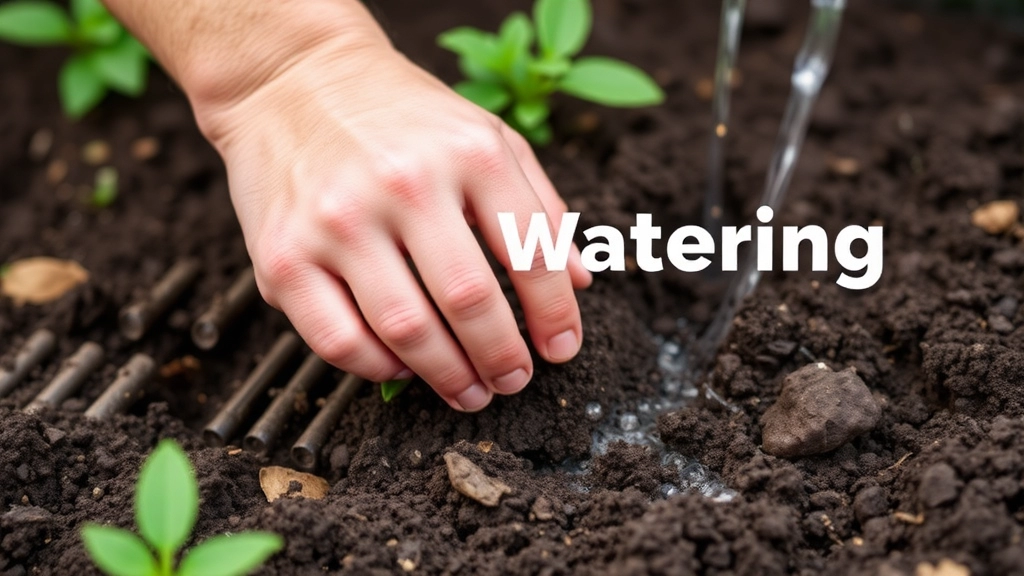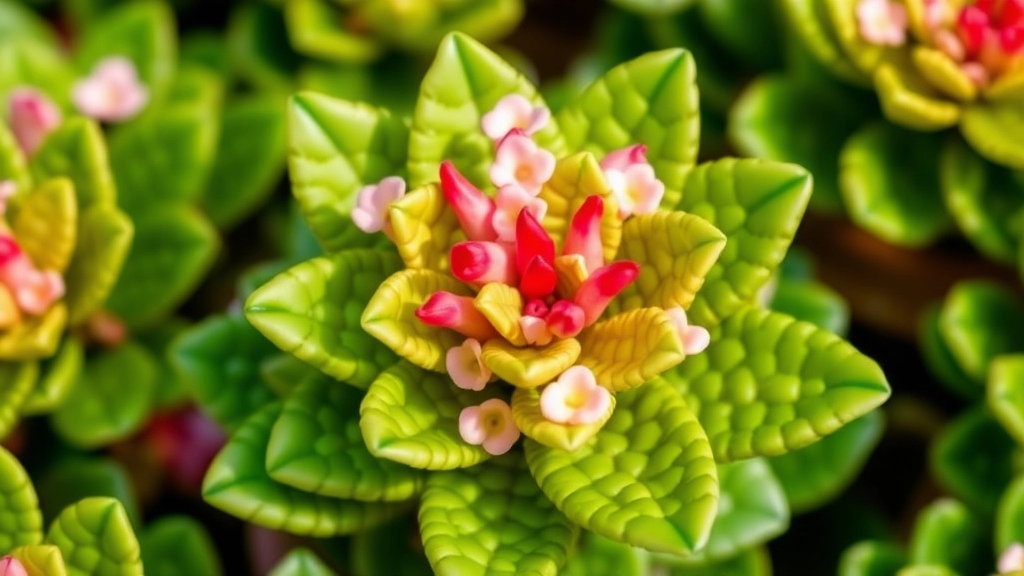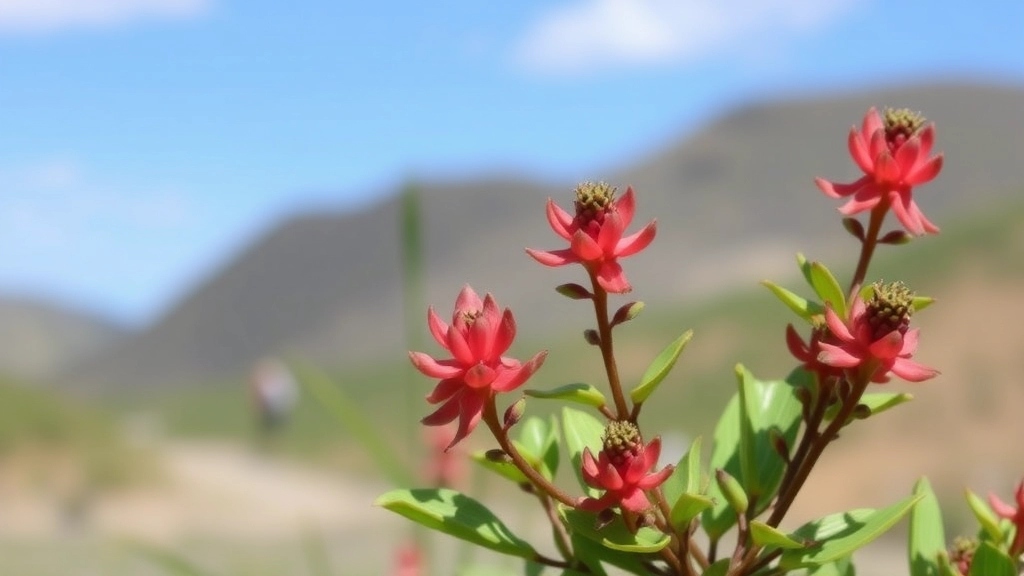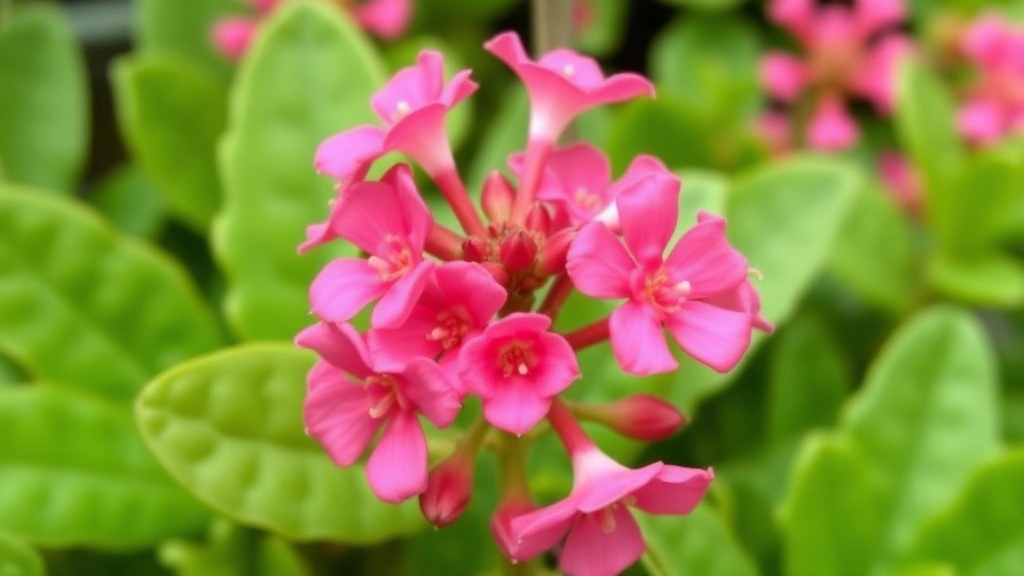Kalanchoe Brasiliensis
When it comes to the Kalanchoe brasiliensis, also known as “Brazilian Kalanchoe,” there’s a lot to discover. This unique succulent is prized not just for its striking appearance but also for its ease of care and fascinating propagation methods. Whether you’re a seasoned gardener or a curious plant enthusiast, understanding the common names and characteristics of Kalanchoe brasiliensis can help you appreciate this plant even more.
Characteristics
Commonly referred to as “Brazilian Kalanchoe,” this plant boasts fleshy leaves and vibrant flowers that can brighten up any space. It’s important to know its light and temperature requirements to ensure it thrives in your home or garden. Additionally, learning about its soil and watering needs will set you up for success in growing a healthy, robust plant.
Care Tips
Stay tuned as we delve into more tips and tricks for caring for your Kalanchoe brasiliensis.
Common Names of Kalanchoe brasiliensis
When exploring the world of Kalanchoe brasiliensis, many people often wonder about its common names. Understanding these names can enhance your connection to this fascinating succulent.
Kalanchoe brasiliensis is commonly known as:
- Brazillian Kalanchoe
- Chandelier Plant
- Mother of Thousands (though this name is often associated with Kalanchoe daigremontiana)
These names reflect its origins and unique characteristics, making it easier for enthusiasts to identify and discuss this plant.
The Brazilian Kalanchoe is particularly renowned for its striking appearance and resilience, appealing to both novice and seasoned gardeners alike. For more detailed care instructions, you can refer to our Chandelier Plant care guide and our Mother of Thousands care and propagation guide.
Characteristics and Appearance

So, you’re curious about Kalanchoe brasiliensis, right? Let’s dive into what makes this plant a standout choice for your home or garden.
What Does Kalanchoe brasiliensis Look Like?
Kalanchoe brasiliensis is a succulent that boasts some pretty unique features.
- Leaves: The leaves are thick, fleshy, and can grow up to 10 cm long. They’re often a lovely shade of green with a slight waxy sheen.
- Flowers: When it blooms, you can expect clusters of tubular flowers that are typically orange or yellow. They add a pop of colour that’s hard to ignore!
- Growth Habit: This plant tends to be bushy and can reach heights of about 30-60 cm. It’s perfect for those wanting to add some greenery without taking up too much space.
Unique Traits
One standout characteristic is its ability to produce small plantlets along the edges of its leaves. These plantlets can easily be propagated, making it a fun plant to grow and share with friends.
Why Choose Kalanchoe brasiliensis?
If you’re looking for a low-maintenance, visually appealing plant, Kalanchoe brasiliensis fits the bill.
- Drought Tolerant: Its succulent nature means it can withstand periods of neglect—perfect for busy folks!
- Air Purifier: Like many succulents, it helps improve indoor air quality, making it both beautiful and functional.
Light and Temperature Requirements
When it comes to caring for Kalanchoe brasiliensis, understanding its light and temperature needs is crucial for optimal growth. Many plant enthusiasts often worry about whether they are providing the right conditions for their beloved Kalanchoe.
Light Requirements
Kalanchoe brasiliensis thrives in bright, indirect sunlight. Here are some key points to consider:
- Ideal Location: Place your plant near a south or west-facing window where it can receive ample light.
- Direct Sunlight: While it can tolerate some direct sunlight, too much can scorch its leaves. Aim for about 4-6 hours of bright light daily.
- Low Light Conditions: If your Kalanchoe is in low light, it may become leggy and fail to flower, so ensure it gets enough brightness.
Temperature Needs
Temperature plays a significant role in the health of your Kalanchoe brasiliensis. Here’s what you need to know:
Soil and Watering Needs

When it comes to caring for Kalanchoe brasiliensis, understanding its soil and watering needs is crucial for promoting healthy growth. Many plant enthusiasts often worry about how to provide the right conditions for their Kalanchoe.
Soil Requirements
Kalanchoe brasiliensis thrives best in well-draining soil. Here are some key points to consider:
- Type: A cactus or succulent mix works wonders. You can also create your own by mixing potting soil with sand or perlite.
- pH Level: Aim for a slightly acidic to neutral pH, ideally between 6.0 and 7.0. This ensures optimal nutrient absorption.
- Drainage: Ensure your pot has drainage holes to prevent waterlogging, which can lead to root rot.
Watering Needs
Watering can be a tricky aspect of Kalanchoe care. Over-watering is a common concern. Here’s how to get it right:
- Frequency: Water every 2-3 weeks during the growing season (spring and summer). Reduce frequency in the dormant months (autumn and winter).
- Method: Water thoroughly until it drains from the bottom. Avoid letting the plant sit in standing water.
- Signs: Look for signs of thirst, such as wrinkled leaves. Conversely, yellowing leaves may indicate over-watering.
Propagation Techniques for Kalanchoe brasiliensis
Many plant enthusiasts often wonder how to propagate Kalanchoe brasiliensis effectively.
This succulent is not only visually appealing but also relatively easy to propagate, making it an excellent choice for both novice and seasoned gardeners.
Growth and Maintenance Tips for Kalanchoe brasiliensis

So, you’ve got your Kalanchoe brasiliensis, and you’re wondering how to keep it thriving, right? Let’s dive into some straightforward tips to help your plant flourish.
1. Light It Up
Kalanchoe brasiliensis loves bright, indirect light.
- Optimal Position: A spot near a window is perfect.
- Avoid Direct Sunlight: Too much can scorch those lovely leaves.
2. Temperature Matters
This plant prefers a warm environment.
- Ideal Range: Keep it between 20°C to 25°C.
- Avoid Cold Drafts: They don’t like chilly surprises.
3. Water Wisely
Overwatering is a common pitfall.
- Check the Soil: Only water when the top inch feels dry.
- Drainage is Key: Ensure your pot has drainage holes to prevent root rot.
4. Fertilize Sparingly
A little goes a long way with Kalanchoe brasiliensis.
- Frequency: Feed it once a month during the growing season.
- Choose the Right Fertilizer: A balanced, water-soluble fertilizer works wonders.
5. Repot When Necessary
Your plant will outgrow its pot eventually.
- Signs It’s Time: Roots coming out of the drainage holes.
- Choose a Slightly Bigger Pot: This gives it room to grow.
6. Watch for Pests
Keep an eye out for common pests like mealybugs and aphids.
- Regular Checks: Inspect leaves regularly.
- Natural Remedies: A mixture of water and dish soap can help.
7. Be Patient
Sometimes, growth takes time.
- Don’t Overdo It: Resist the urge to fuss over it too much.
- Enjoy the Journey: Each plant is unique, and it’ll find its groove.
As we explore the growth and maintenance of Kalanchoe brasiliensis, one crucial aspect is pruning and shaping.
Many plant enthusiasts wonder how to keep their Kalanchoe healthy and aesthetically pleasing.
### Why Prune?
Pruning serves several purposes:
– **Encourages New Growth:** Regular pruning stimulates fresh growth, leading to a fuller plant.
– **Removes Dead or Diseased Leaves:** This keeps your plant healthy and reduces the risk of pests.
– **Shapes the Plant:** Pruning helps maintain a desired shape, enhancing its visual appeal.
### When to Prune?
The best time to prune Kalanchoe brasiliensis is during its active growing season, typically in spring or early summer.
### How to Prune:
1. **Use Clean Tools:** Always use sterilised scissors or pruning shears to prevent disease.
2. **Identify the Right Leaves:** Look for dead, yellowing, or damaged leaves to remove first.
3. **Cut at the Base:** For larger leaves, cut close to the stem to encourage new growth.
4. **Shape as Desired:** Trim back any long or leggy stems to maintain a compact shape.
### Shaping Techniques:
– **Pinching:** For a bushier appearance, pinch back the tips of the stems.
– **Selective Pruning:** Focus on specific areas to create a balanced look.
By integrating these pruning techniques, you can ensure your Kalanchoe brasiliensis remains vibrant and well-shaped. For more expert tips on maintaining your Kalanchoe, check out our [comprehensive care guide](https://planthq.org/how-to-care-for-a-kalanchoe-succulent-expert-tips/) and learn about different [pruning methods for Kalanchoe](https://planthq.org/kalanchoe-tomentosa-propagation-guide-stepbystep-tips/).
Disease and Pest Prevention

So, you’ve got your lovely Kalanchoe brasiliensis thriving, but what about those pesky diseases and pests?
Common Pests to Watch For:
- Aphids: Tiny, greenish bugs that suck the sap from your plant.
- Mealybugs: White, cottony masses that cling to the leaves and stems.
- Spider Mites: Tiny spiders that create fine webs, often found on the underside of leaves.
Signs of Trouble:
- Yellowing leaves?
- Wilting or drooping?
- Visible bugs or webbing?
Prevention Tips:
- Maintain Good Airflow: Keep your plant in a spot with plenty of ventilation.
- Inspect Regularly: Check for pests weekly; catching them early is key.
- Use Neem Oil: A natural pesticide that’s effective against many common pests.
- Keep it Clean: Wipe down leaves with a damp cloth to remove dust and potential pests.
Disease Prevention:
- Root Rot: Avoid overwatering. Make sure the pot has drainage holes.
- Fungal Issues: Water the soil, not the leaves. This helps keep mildew at bay.
Remember, a healthy plant is less likely to attract pests.
Seasonal Care for Kalanchoe brasiliensis
As we transition through the seasons, understanding how to care for Kalanchoe brasiliensis becomes crucial for its health and vitality. Many new plant owners often wonder how to adjust their care routines throughout the year.
Medicinal and Ethnobotanical Uses of Kalanchoe brasiliensis

Now that we’ve explored how to care for your Kalanchoe brasiliensis, let’s dive into its fascinating medicinal and ethnobotanical uses.
Have you ever wondered if that lovely plant on your windowsill could do more than just look pretty?
Traditional Uses
Kalanchoe brasiliensis has a rich history in traditional medicine, particularly in various cultures.
- Wound Healing: Many folks use its leaves to treat cuts and bruises. The sap is said to have antiseptic properties, helping to speed up healing.
- Anti-inflammatory: Some believe that Kalanchoe can help reduce inflammation, making it a go-to for minor aches and pains.
- Respiratory Aid: In some cultures, it’s used to alleviate respiratory issues. A tea made from its leaves is thought to soothe coughs and colds.
Modern Research
While traditional uses are fascinating, modern science has started to catch up.
- Antimicrobial Properties: Studies suggest that Kalanchoe brasiliensis may possess antimicrobial effects, making it a potential candidate for natural remedies.
- Cancer Research: Some research is exploring its compounds for possible anti-cancer properties. This is still in the early stages, but it’s an exciting area of study.
How to Use
If you’re keen to explore these benefits, here are some simple ways to incorporate Kalanchoe brasiliensis into your routine:
- Topical Application: Crush the leaves and apply them directly to minor wounds or skin irritations.
- Herbal Tea: Steep the leaves in hot water for a soothing tea. Just remember to consult with a healthcare professional before trying any new remedies!
Cultural Significance
In many cultures, Kalanchoe brasiliensis is more than just a plant; it’s a symbol of healing and wellness.
People often share stories of how it has helped them or their loved ones, creating a sense of community and shared knowledge.
When considering the best environment for Kalanchoe brasiliensis, many enthusiasts often find themselves torn between indoor and outdoor cultivation. Each option has its unique benefits and challenges, and understanding these can help you make an informed decision.
### Indoor Cultivation
Growing Kalanchoe brasiliensis indoors can be a rewarding experience, especially if you have limited outdoor space or live in a cooler climate. Here are some key points to consider:
– **Light Requirements**: Place your Kalanchoe brasiliensis near a south-facing window to ensure it receives ample sunlight. If natural light is limited, consider using grow lights.
– **Temperature Control**: Indoor environments typically maintain stable temperatures, ideally between 18°C to 24°C. Avoid placing your plant near drafts or heating vents.
– **Humidity Levels**: Indoor air can be dry, especially during winter. A humidity tray or occasional misting can help maintain optimal moisture levels.
– **Pest Management**: Indoor plants are generally less susceptible to pests, but keep an eye out for mealybugs and spider mites. Regular inspections can help catch any issues early.
### Outdoor Cultivation
On the other hand, cultivating Kalanchoe brasiliensis outdoors can lead to vigorous growth and blooming. Here are some considerations for outdoor gardening:
– **Sunlight**: Kalanchoe brasiliensis thrives in full sun. Ensure your outdoor location receives at least 6 hours of direct sunlight daily.
– **Temperature Tolerance**: This plant prefers warmer climates. If you live in a region with mild winters, it can be left outside year-round. However, protect it from frost.
– **Soil Quality**: Outdoor soil should be well-draining. Amending with sand or perlite can improve drainage, preventing root rot.
– **Pest Awareness**: Outdoor plants may face more pests and diseases. Regular monitoring and preventive measures, such as neem oil, can keep your plant healthy.
For more detailed guidance, you might find our [complete care guide for Kalanchoe brasiliensis](https://planthq.org/complete-care-guide-for-kalanchoe-beharensis-felt-plant/) particularly useful. Additionally, if you’re interested in other varieties, check out our article on [top Kalanchoe succulent varieties and care tips](https://planthq.org/top-kalanchoe-succulent-varieties-and-care-tips/).
Common Misconceptions and FAQs
When diving into the world of Kalanchoe brasiliensis, it’s easy to stumble upon some myths and questions that can leave you scratching your head. Let’s clear up some of the most common misconceptions and tackle those burning FAQs.
Misconception 1: Kalanchoe brasiliensis is Poisonous
Many folks think that Kalanchoe brasiliensis is toxic, especially for pets. While it’s true that some Kalanchoe species can be harmful, Kalanchoe brasiliensis is generally considered safe when handled properly.
Tip: Always keep an eye on your pets around houseplants, just to be safe! For more information on the safety of Kalanchoe plants, check out our guide on Kalanchoe toxicity and safety tips.
Misconception 2: It Needs Constant Sunlight
Another common belief is that this plant requires full sun all day long. In reality, Kalanchoe brasiliensis thrives best in bright, indirect light. Too much direct sunlight can scorch its leaves.
Quick Check: If your plant’s leaves start to look crispy, it might be time to move it to a shadier spot. Learn more about the optimal care for Kalanchoe growth.
FAQ 1: How Often Should I Water My Kalanchoe brasiliensis?
Watering can be tricky! A good rule of thumb is to let the soil dry out between waterings. Depending on your environment, this could mean watering every 2-3 weeks.
Pro Tip: Stick your finger in the soilâif it’s dry up to your first knuckle, it’s time to water.
FAQ 2: Can I Propagate My Kalanchoe brasiliensis Easily?
Absolutely! Propagation is one of the fun parts of caring for this plant. You can do it through leaf cuttings or offsets. Just make sure to let the cuttings callous over for a day or two before planting them in soil.
Fun Fact: I’ve had great success with leaf cuttingsâjust place them in well-draining soil and keep them warm!
FAQ 3: Is Kalanchoe brasiliensis Suitable for Beginners?
Definitely! This plant is quite forgiving and perfect for those just starting their plant journey. It doesn’t require a ton of fuss, making it a great choice for novice gardeners.
FAQ 4: What Should I Do If My Plant Looks Sick?
If your Kalanchoe brasiliensis starts to droop or develop spots, check for pests or overwatering issues. Adjust your care routine accordingly, and it should bounce back in no time.
Remember: Regularly inspecting your plant can help catch problems early.
FAQs about Kalanchoe brasiliensis
What is the common name for Kalanchoe brasiliensis?
Kalanchoe brasiliensis is commonly known simply as Kalanchoe.
What are the unique features of Kalanchoe brasiliensis?
Kalanchoe brasiliensis is a succulent with thick, fleshy leaves that can grow up to 10 cm long. It produces clusters of tubular flowers, typically orange or yellow, and can reach heights of 30-60 cm. One standout trait is its ability to produce small plantlets along the edges of its leaves, which can be easily propagated.
How do I care for Kalanchoe brasiliensis?
Kalanchoe brasiliensis thrives in well-draining soil and requires watering every 2-3 weeks during the growing season. It prefers bright, indirect light and a warm environment between 20°C to 25°C. Overwatering should be avoided, and the plant should be fertilized sparingly during the growing season.
What type of soil is best for Kalanchoe brasiliensis?
Kalanchoe brasiliensis thrives best in well-draining soil, such as a cactus or succulent mix. You can also create your own mix by combining potting soil with sand or perlite. The ideal pH level is slightly acidic to neutral, between 6.0 and 7.0.
How often should I water Kalanchoe brasiliensis?
Water Kalanchoe brasiliensis every 2-3 weeks during the growing season (spring and summer). Reduce the frequency in the dormant months (autumn and winter). Water thoroughly until it drains from the bottom, but avoid letting the plant sit in standing water.
What are common pests and diseases affecting Kalanchoe brasiliensis?
Common pests include aphids, mealybugs, and spider mites. Signs of trouble include yellowing leaves, wilting, and visible bugs or webbing. To prevent diseases, avoid overwatering to prevent root rot and water the soil, not the leaves, to keep fungal issues at bay.
What are the medicinal uses of Kalanchoe brasiliensis?
Kalanchoe brasiliensis has traditional medicinal uses, including wound healing, anti-inflammatory properties, and respiratory aid. Modern research suggests it may have antimicrobial properties and potential anti-cancer compounds.
How can I use Kalanchoe brasiliensis for its medicinal benefits?
You can crush the leaves and apply them directly to minor wounds or skin irritations. Alternatively, you can steep the leaves in hot water to make a soothing herbal tea. Always consult with a healthcare professional before trying any new remedies.
What are the signs that my Kalanchoe brasiliensis needs repotting?
If you notice roots coming out of the drainage holes, it’s time to repot your Kalanchoe brasiliensis. Choose a slightly bigger pot to give it room to grow.
How can I prevent pests on my Kalanchoe brasiliensis?
Maintain good airflow, inspect the plant regularly, and use natural remedies like neem oil or a mixture of water and dish soap. Keeping the leaves clean by wiping them with a damp cloth can also help prevent pests.
What cultural significance does Kalanchoe brasiliensis hold?
In many cultures, Kalanchoe brasiliensis is a symbol of healing and wellness. People often share stories of how it has helped them or their loved ones, creating a sense of community and shared knowledge.
References
-
Medicinal Uses of Kalanchoe brasiliensis
-
Gardening Tips for Kalanchoe brasiliensis
-
Growing and Caring for Kalanchoe brasiliensis
